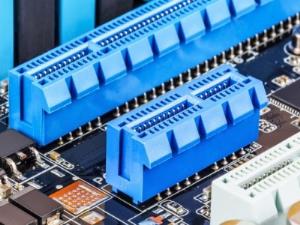



Date:30/05/19
 The PCI-SIG organization has released the final PCI Express 5.0 specification. The new interconnect standard doubles the bandwidth to 32 GT/s per lane less than two years after PCIe 4.0 debuted. PCI-SIG members can download the full specification from the organization's website.
The PCI-SIG organization has released the final PCI Express 5.0 specification. The new interconnect standard doubles the bandwidth to 32 GT/s per lane less than two years after PCIe 4.0 debuted. PCI-SIG members can download the full specification from the organization's website.
PCI-SIG Chairman and President Al Yanes said the standard was completed in 18 months. "New data-intensive applications are driving demand for unprecedented levels of performance," Yanes said in the announcement. "The PCIe architecture will continue to stand as the [de facto] standard for high performance I/O for the foreseeable future."
Via an x16 configuration, PCIe 5.0 allows up to 128 GB/s bandwidth, twice that of PCIe 4.0. The PCIe 5.0 architecture also implements electrical changes to improve signal integrity and mechanical performance of connectors. Like prior versions, the standard maintains backwards compatibility with earlier PCIe versions, meaning earlier versions will continue to work over PCIe 5.0 interfaces, although they won’t be able to leverage the higher speed. Lastly, it includes a new backwards compatible CEM connector targeted for add-in cards.
The first meaningful PCIe 4.0 products for consumers are only being released this year, most notably the CPUs and GPUs from AMD, which most likely means that PCIe 5.0 will be a relatively fast follow-up. Intel has already announced that its Agilex FPGA will support PCIe 5.0, and its cache-coherent Compute Express Link (CXL) relies on PCIe 5.0. The company plans to release CXL products, which could be the first to support PCIe 5.0, in 2021.
PCI-SIG Releases Final PCIe 5.0 Specification
 The PCI-SIG organization has released the final PCI Express 5.0 specification. The new interconnect standard doubles the bandwidth to 32 GT/s per lane less than two years after PCIe 4.0 debuted. PCI-SIG members can download the full specification from the organization's website.
The PCI-SIG organization has released the final PCI Express 5.0 specification. The new interconnect standard doubles the bandwidth to 32 GT/s per lane less than two years after PCIe 4.0 debuted. PCI-SIG members can download the full specification from the organization's website.PCI-SIG Chairman and President Al Yanes said the standard was completed in 18 months. "New data-intensive applications are driving demand for unprecedented levels of performance," Yanes said in the announcement. "The PCIe architecture will continue to stand as the [de facto] standard for high performance I/O for the foreseeable future."
Via an x16 configuration, PCIe 5.0 allows up to 128 GB/s bandwidth, twice that of PCIe 4.0. The PCIe 5.0 architecture also implements electrical changes to improve signal integrity and mechanical performance of connectors. Like prior versions, the standard maintains backwards compatibility with earlier PCIe versions, meaning earlier versions will continue to work over PCIe 5.0 interfaces, although they won’t be able to leverage the higher speed. Lastly, it includes a new backwards compatible CEM connector targeted for add-in cards.
The first meaningful PCIe 4.0 products for consumers are only being released this year, most notably the CPUs and GPUs from AMD, which most likely means that PCIe 5.0 will be a relatively fast follow-up. Intel has already announced that its Agilex FPGA will support PCIe 5.0, and its cache-coherent Compute Express Link (CXL) relies on PCIe 5.0. The company plans to release CXL products, which could be the first to support PCIe 5.0, in 2021.
Views: 437
©ictnews.az. All rights reserved.Similar news
- Azerbaijani project to monitor disease via mobile phones
- Innovative educational system to be improved under presidential decree
- NTRC prolongs license of two TV and radio organizations for 6 years
- Azerbaijan establishes e-registry for medicines
- Azerbaijani museum introduces e-guide
- Nar Mobile opens “Nar Dunyasi” sales and service center in Siyazan city
- International conference on custom electronic services held in Baku
- OIC secretary general to attend COMSTECH meeting in Baku
- Azerbaijan develops earthquake warning system
- New law to regulate transition to digital broadcasting in Azerbaijan
- Azerbaijani State Social Protection Fund introduces electronic digital signature
- Intellectual traffic management system in Baku to be commissioned in December
- Tax Ministry of Azerbaijan started receiving video-addresses
- World Bank recommends Azerbaijan to speed up e-service introduction in real estate
- Azerbaijan to shift to electronic registration of real estate





















